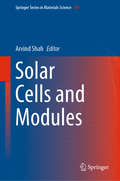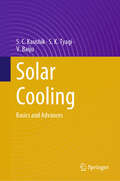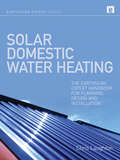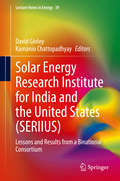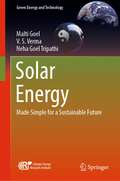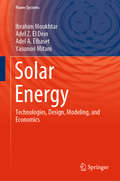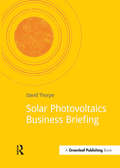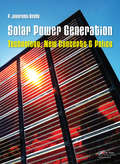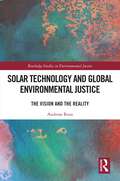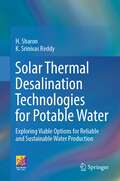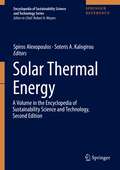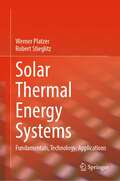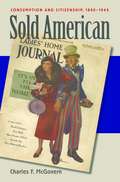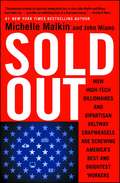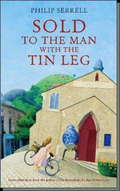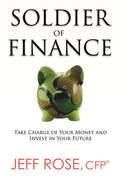- Table View
- List View
Solagen: Process Improvement in the Manufacture of Gelatin at Kodak
by Brian J. Delacey Dorothy Leonard-BartonKodak must decide whether to make a major investment in a production facility designed around a new technique for producing the gelatin critical to so many film and paper products. Currently, gelatin making is an arcane art, unchanged in 150 years and heavily dependent upon the sensory skills of experienced foremen. The new process, in a pilot stage now, is a chemical reaction which reduces the process time for one step from 6 months to 48 hours and which is much more "scientific." However, the old plant is fully paid for, the new process is only one potential avenue for improvement, and demand for gelatin is falling.
Solar Cells and Modules (Springer Series in Materials Science #301)
by Arvind ShahThis book gives a comprehensive introduction to the field of photovoltaic (PV) solar cells and modules. In thirteen chapters, it addresses a wide range of topics including the spectrum of light received by PV devices, the basic functioning of a solar cell, and the physical factors limiting the efficiency of solar cells. It places particular emphasis on crystalline silicon solar cells and modules, which constitute today more than 90 % of all modules sold worldwide. Describing in great detail both the manufacturing process and resulting module performance, the book also touches on the newest developments in this sector, such as Tunnel Oxide Passivated Contact (TOPCON) and heterojunction modules, while dedicating a major chapter to general questions of module design and fabrication. Overall, it presents the essential theoretical and practical concepts of PV solar cells and modules in an easy-to-understand manner and discusses current challenges facing the global research and development community.
Solar Cooling: Basics and Advances
by S. C. Kaushik S. K. Tyagi V. BaijuThe book deals with the research activities focussed on solar VAD systems evaluating its merit of compatibility with ozone friendly refrigerants and adoptability with solar energy option. The authors of this book have given more emphasis on discussing various solar cooling VAD systems and its viability for the commercial use. Relevant references on "Solar Cooling: Basics and Advances" has been provided which significantly adopt some of the information for the completeness of the book.
Solar Domestic Water Heating: The Earthscan Expert Handbook for Planning, Design and Installation (Earthscan Expert)
by Chris LaughtonSolar Domestic Water Heating is a comprehensive introduction to all aspects of solar domestic water heating systems. As fossil fuel prices continue to rise and awareness of climate change grows, interest in domestic solar water heating is expanding. Solar water heating technology is the most environmentally-friendly way to heat water. This fully-illustrated and easy-to-follow guide shows how domestic solar water heating systems work, the different types of systems, types of collectors, both flat plate and evacuated tube, types of storage tanks and other accessories. It also shows how systems are installed and explains how solar water heating can be integrated into existing water heating systems. Numerous examples from around the world have been included. The ideal guide for plumbers, heating engineers, builders and architects, housing and property developers, home owners and DIY enthusiasts, and anyone who needs a clear introduction to solar water heating technology.
Solar Energy Conversion in Communities: Proceedings of the Conference for Sustainable Energy (CSE) 2020 (Springer Proceedings in Energy)
by Ion Visa Anca DutaThis book presents novel findings concerning the systems, materials and processes used in solar energy conversion in communities. It begins with the core resource – solar radiation – and discusses the restrictions on the wide-scale implementation of conversion systems imposed by the built environment, as well as potential solutions. The book also describes efficient solar energy conversion in detail, focusing on heat and electricity production in communities and water reuse. Lastly, it analyzes the concept of sustainable communities, presenting examples from around the globe, along with novel approaches to improving their feasibility and affordability. Though chiefly intended for professionals working in the field of sustainability at the community level, the book will also be of interest to researchers, academics and doctoral students.
Solar Energy Research Institute for India and the United States: Lessons and Results from a Binational Consortium (Lecture Notes in Energy #39)
by David Ginley Kamanio ChattopadhyayThis book describes the development, functioning, and results of a successful binational program to promote significant scientific advances in Earth-abundant photovoltaics (PV) and concentrated solar power (CSP), advanced process/manufacturing technologies, multiscale modeling and reliability testing, and analysis of integrated solar energy systems. SERIIUS is a consortium between India and the United States dedicated to developing new solar technologies and assessing their potential impact in the two countries. The consortium consists of nearly 50 institutions including academia, national laboratories, and industry, with the goal of developing significant new technologies in all areas of solar deployment. In addition, the program focused on workforce development through graduate students, post-doctoral students, and an international exchange program. Particular emphasis was placed on the following efforts: Creating disruptive technologies in PV and CSP through high-impact fundamental and applied research and development (R&D). Identifying and quantifying the critical technical, economic, and policy issues for solar energy development and deployment in India. Overcoming barriers to technology transfer by teaming research institutions and industry in an effective project structure. Building a new platform for binational collaboration using a formalized R&D project structure, along with effective management, coordination, and decision processes. Creating a sustainable network and workforce development program from which to build large collaborations and fostering a collaborative culture and outreach programs. This includes using existing and new methodologies for collaboration based on advanced electronic and web-based communication to facilitate functional international teams. The book summarizes the general lessons learned from these experiences.
Solar Energy, Mini-grids and Sustainable Electricity Access: Practical Experiences, Lessons and Solutions from Senegal (Routledge Focus on Environment and Sustainability)
by Debajit Palit Kirsten Ulsrud Charles Muchunku Gathu KirubiThis book presents new research on solar mini-grids and the ways they can be designed and implemented to provide equitable and affordable electricity access, while ensuring economic sustainability and replication. Drawing on a detailed analysis of solar mini-grid projects in Senegal, the book provides invaluable insights into energy provision and accessibility which are highly relevant to Sub-Saharan Africa, and the Global South more generally. Importantly, the book situates mini-grids in rural villages within the context of the broader dynamics of national- and international-level factors, including emerging system innovation and socio-technical transitions to green technologies. The book illustrates typical challenges and potential solutions for practitioners, policymakers, donors, investors and international agencies. It demonstrates the decisive roles of suitable policies and regulations for private-sector-led mini-grids and explains why these policies and regulations must be different from those that are designed as part of an established, centralized electricity regime. Written by both academics and technology practitioners, this book will be of great interest to those researching and working on energy policy, energy provision and access, solar power and renewable energy, and sustainable development more generally.
Solar Energy: Made Simple for a Sustainable Future (Green Energy and Technology)
by Malti Goel V. S. Verma Neha Goel TripathiThis book presents the achievements made in solar energy and prospects in achieving solar potential in India. It covers the historical perspectives, innovations and myriad applications of solar energy in its different forms. The book discusses solar devices and covers both solar photovoltaics and solar thermal energy and includes both heat and electricity applications. Solar policies in India, solar research, technologies, large scale adoption as well as future trends are also discussed. This book will be useful for researchers and professionals with interests in technological, economical and policy developments in solar energy driven power industry.
Solar Energy: Technologies, Design, Modeling, and Economics (Power Systems)
by Adel A. Elbaset Yasunori Mitani Ibrahim Moukhtar Adel Z. El DeinThis book opens with a brief introduction to renewable energy and the advantages of solar energy systems, an overview of concentrated solar power (CSP) system technologies and modeling, and the application of artificial neural network (ANN) technologies in various solar field systems. Later chapters cover data and operation methods of central tower receiver power plants (CTRPP), important models of ANN techniques used in solar energy fields, accurate methods for modeling CTRPP, the economics of solar energy systems, the CSP impacts on the penetration level of photovoltaic (PV) systems, and a look at the reliability of systems using case studies on PV systems and hybrid PV and CSP systems.Provides an introduction to renewable energy and the advantages of solar energy systemsOutlines methods for modeling central tower receiver power plantsIncludes case studies on photovoltaic (PV) and hybrid PV and concentrated solar power systems
Solar Geoengineering
by Joseph B. Lassiter Stephanie PuzioOn December 8th 2013, as Dr. David Keith was leaving the set of the Colbert Show, he couldn't help but replay the interview over and over in his mind. Did he actually get his point of view on solar geoengineering across or had he just added to the stereotype that he was more of a 'mad scientist' than a scholar? Science knew, beyond doubt, that volcanoes cooled the planet by forcing sulfates high into the stratosphere. This cooling effect had been recorded in history over and over again. The question that Keith and many other climate scientists wanted to answer was: could humanity learn how to design, deploy, and manage similar cooling effects to manage the threats from climate change?
Solar Photovoltaics Business Briefing (Doshorts Ser.)
by David ThorpeThis book explains, for a UK business audience, the technical, scientific and economic aspects of solar photovoltaics (PV) technologies. It is useful to anyone considering a business use of solar PV, whether an investor, potential purchaser, or thinking of setting up a company in the sector.It succinctly examines: their applications and how to assess them; the prospects and drivers for cost reductions and implementation; the role of PV in carbon offsetting; and the business case for and against investment.It will arm the reader with sufficient knowledge to talk to contractors or to compile a business investment case for senior management.PV is the sunrise sector for electricity generation; the renewable technology whose time has come. Clean, and with no moving parts to wear out, it interfaces neatly with other technologies, both digital and analogue. Cost curves are decreasing and installation curves exponentially rising. Although silicon-based cells are well-known, due to the feed-in tariff support they receive, within the next five to eight years, lowering production costs and technological innovations will mean that solar electricity will be poised to find even more widespread applications.
Solar Power Generation: Technology, New Concepts & Policy
by P. Jayarama ReddyThis book offers a global perspective of the current state of affairs in the field of solar power engineering. In four parts, this well-researched volume informs about:Established solar PV (photovoltaic) technologiesThird-generation PV technologies based on new materials with potential for low-cost large-scale productionSolar cell technology based
Solar Resources Mapping: Fundamentals and Applications (Green Energy and Technology)
by Jesús Polo Luis Martín-Pomares Antonio SanfilippoThis book presents methods for optimising the spatial and network configuration of solar radiation measuring stations. Various physical and mathematical models are demonstrated, which together with high quality measurements, provide the essential tools to generate and validate solar resource estimates to improve the mapping of solar resources.Each chapter deals with a specific topic, showing its methodology, and providing examples of how to apply these techniques with reference to current projects around the world. These topics include:· Radiometric measurement campaigns;· Equipment calibration, installation, operation, and maintenance;· Data quality assurance and assessment;· Solar radiation modelling from satellite images and numerical models;· Downscaling and kriging interpolation of solar radiation;· Simulation of electric solar power plant generation;· Solar radiation forecasting;· Applications of solar energy; and· Socio-economic benefits of solar energy.The contributors present the statistical and physical models needed to derive solar radiation from satellite images and numerical models, emphasising the importance of measuring solar radiation accurately. They also show the classical models used to generate synthetic data, clear sky models and ancillary air quality and meteorological data from different input sources.Solar Resources Mapping provides industry professionals with methodologies and tools to build solar irradiance maps for different applications. The book will also benefit students and researchers as it serves as a main technical reference, presenting the basic terminology and fundamentals for solar resource mapping that include methods for assessing measurement uncertainty.
Solar Revolution: The Economic Transformation of the Global Energy Industry (The\mit Press Ser.)
by Travis BradfordAn innovative analysis that shows how the shift to solar energy—in particular, the use of photovoltaic cells—is both economically advantageous and inevitable, and will rival the information and communication technologies revolution in its transformative effects.In Solar Revolution, fund manager and former corporate buyout specialist Travis Bradford argues—on the basis of standard business and economic forecasting models—that over the next two decades solar energy will increasingly become the best and cheapest choice for most electricity and energy applications. Solar Revolution outlines the path by which the transition to solar technology and sustainable energy practices will occur.Developments in the photovoltaic (PV) industry over the last ten years have made direct electricity generation from PV cells a cost-effective and feasible energy solution, despite the common view that PV technology appeals only to a premium niche market. Bradford shows that PV electricity today has become the choice of hundreds of thousands of mainstream homeowners and businesses in many markets worldwide, including Japan, Germany, and the American Southwest. Solar energy will eventually be the cheapest source of energy in nearly all markets and locations because PV can bypass the aging and fragile electricity grid and deliver its power directly to the end user, fundamentally changing the underlying economics of energy. As the scale of PV production increases and costs continue to decline at historic rates, demand for PV electricity will outpace supply of systems for years to come. Ultimately, the shift from fossil fuels to solar energy will take place not because solar energy is better for the environment or energy security, or because of future government subsidies or as yet undeveloped technology. The solar revolution is already occurring through decisions made by self-interested energy users. The shift to solar energy is inevitable and will be as transformative as the last century's revolutions in information and communication technologies.
Solar Technology and Global Environmental Justice: The Vision and the Reality (Routledge Studies in Environmental Justice)
by Andreas RoosBuilding on insights from ecological economics and philosophy of technology, this book offers a novel, interdisciplinary approach to understand the contradictory nature of Solar photovoltaic (PV) technology. Solar photovoltaic (PV) technology is rapidly emerging as a cost-effective option in the world economy. However, reports about miserable working conditions, environmentally deleterious mineral extraction and toxic waste dumps corrode the image of a problem-free future based on solar power. Against this backdrop, Andreas Roos explores whether ‘ecologically unequal exchange’ – an asymmetric transfer of labour time and natural resources – is a necessary condition for solar PV development. He demonstrates how the massive increase in solar PV installation over recent years would not have been possible without significant wage/price differences in the world economy - notably between Europe/North America and Asia- and concludes that solar PV development is currently contingent on environmental injustices in the world economy. As a solution, Roos argues that solar technology is best coupled with strategies for degrowth, which allow for a transition away from fossil fuels and towards a socially just and ecologically sustainable future. This book will be of great interest to students and scholars of solar power, philosophy of technology, and environmental justice.
Solar Thermal Desalination Technologies for Potable Water: Exploring Viable Options for Reliable and Sustainable Water Production
by H. Sharon K. Srinivas ReddyThis book covers the basics and advancements in various solar thermal desalination systems that are highly affordable and viable even for applications in low-income countries. Fresh water is an essential natural resource needed for the continuous existence of living organisms on earth. Civilizations have started and flourished along riverbanks which can be understood from historical literature. This precious resource has also been a cause for a lot of past and current wars and conflicts among different ethnic groups and nations around the globe. In the current scenario, access to clean drinking water is getting harder and more expensive for most of the population in middle- and low-income countries. This volume provides detailed knowledge on effectively utilizing solar energy for desalination to fulfill clean water supply demands. The content presents detailed thermodynamic modeling of various solar thermal desalination systems and highlights the role of the solar thermal distillation process in wastewater treatment and improved sanitation through a case study. The book also provides a detailed methodology for assessing the economics, environmental footprints, and sustainability of desalination systems. The book will be highly beneficial for researchers, professionals, and activists dealing with water, energy, and the environment.
Solar Thermal Energy (Encyclopedia of Sustainability Science and Technology Series)
by Spiros Alexopoulos Soteris A. KalogirouThis volume of the Encyclopedia of Sustainability Science and Technology, Second Edition, describes technologies that actively convert solar radiation into useful heat in a temperature range from just above ambient up to more than 1,000°C. Applications cover a broad range of energy services such as space heating, cooking, domestic hot water supply, electrical power generation, and high temperature thermochemical processes. The major developments that have led to currently available technologies for solar thermal energy applications were initiated mainly after the first oil shock in 1973. Solar thermal energy is widely used already for heating purposes (water, space) in the “low” temperature range up to about 100°C employing mainly nonconcentrating collectors, whereas higher temperatures can be achieved with more sophisticated solar collector technologies. Temperatures over 200°C typically require concentrating solar radiation using mirror systems. Several different technologies are described in detail in this volume, including solar collector systems in the lower temperature range, the direct use of solar radiation for food processing, namely cooking and drying, the production of electricity through conversion of solar radiation first to heat, driving a mechanical conversion system coupled to an electric generator, the use of solar radiation to drive chemical processes, and many more.
Solar Thermal Energy Systems: Fundamentals, Technology, Applications
by Robert Stieglitz Werner PlatzerThis textbook is intended for master's level engineering students in the field of their studies. It begins with an analysis of the growing world population's energy demand (heat and electricity) and its connection to the undeniable climate change, necessitating the expansion of climate-friendly technologies. The book is divided into two sections. The first section (Chapters 2 to 7) presents the physical fundamentals of solar thermal energy usage, along with the necessary processes, methods, and models. The second section (Chapters 8-12) covers the synthesis of the developed fundamentals applied to various functional solar thermal systems. It not only provides the logic and methods for transferring the physical fundamentals into an operative technical system but also includes aspects of concept development, selection, economic evaluation, and performance. Additionally, measurement and control technology are presented, underpinned by real projects that have already been successfully implemented.
Solarnomics: Setting Up and Managing a Profitable Solar Business
by David WrightSolar power has come of age. Not only has it become one of the key alternatives to fossil fuels, it can now be deployed in a way that makes a viable business with a financial profit. This book shows industry professionals and students how to do just that. Solarnomics describes the economics of building and operating a solar power plant today and provides a window into a future in which several technologies collaborate, and in which all participants in the electricity grid become smarter at scheduling both the supply and demand for electric power to give humanity a future that is sustainable, both environmentally and economically. The book shows how to estimate costs and revenues, how to tweak the design of a project to improve profitability, how to calculate return on investment, how to assess and deal with risk, how to raise capital, how to combine solar with batteries to make a hybrid microgrid, and how to be prepared for future developments in the evolving smart electricity grid. Solarnomics will enable professionals in the solar industry to assess the potential profitability of a proposed solar project, and it will enable students to add an extra dimension to their understanding of sustainability.
Sold American
by Charles F. McgovernAt the turn of the twentieth century, an emerging consumer culture in the United States promoted constant spending to meet material needs and develop social identity and self-cultivation. In Sold American, Charles F. McGovern examines the key players active in shaping this cultural evolution: advertisers and consumer advocates. McGovern argues that even though these two professional groups invented radically different models for proper spending, both groups propagated mass consumption as a specifically American social practice and an important element of nationality and citizenship.Advertisers, McGovern shows, used nationalist ideals, icons, and political language to define consumption as the foundation of the pursuit of happiness. Consumer advocates, on the other hand, viewed the market with a republican-inspired skepticism and fought commercial incursions on consumer independence. The result, says McGovern, was a redefinition of the citizen as consumer. The articulation of an "American Way of Life" in the Depression and World War II ratified consumer abundance as the basis of a distinct American culture and history.
Sold Out: How Broken Supply Chains, Surging Inflation, and Political Instability Will Sink the Global Economy
by James RickardsFrom the man who predicted the worst economic crisis in US history comes Jim Rickards&’ second prediction – the collapse of our global economy.The supply chain crisis is coming to a head. Today, your favorite products are missing from store shelves, caught in supply chain limbo somewhere in the Pacific Ocean. But what does this supply chain disruption look like six months, or even three years, from now? While we hope that post-pandemic recovery will absolve these issues, the reality is that digital currency, meme stonks, and social media can&’t solve the age-old problem of producing and moving physical goods across oceans and continents. According to Jim Rickards, consumer frustration is only the tip of a very large, menacing iceberg that threatens global economic collapse.In Sold Out, Rickards shares his predictions for our post-pandemic future and outlines how consumers and business owners can get ahead of the collapse. You&’ll learn how energy shortages in China – fueled by the trade war with Australia – are disrupting the steel market and forcing entire factories to shut down. You&’ll also learn how rising inflation will ultimately lead to deflation in a few short years – as consumer spending eventually tanks due to higher taxes, excessive debt, and increased layoffs – and why such economic conditions will closely resemble the 1930s. Finally, Rickards will look at the future of money, including the erasure of the American dollar itself.Our global economy faces unprecedented challenges in the next few months. But whether we sink or swim depends on how prepared we are – and what we do now to thwart the coming collapse.
Sold Out: How High-Tech Billionaires & Bipartisan Beltway Crapweasels Are Screwing America's Best & Brightest Workers
by Michelle Malkin John MianoThe #1 New York Times bestselling author and firebrand syndicated columnist Michelle Malkin sets her sights on the corrupt businessmen, politicians, and lobbyists flooding our borders and selling out America's best and brightest workers.In Sold Out, Michelle Malkin and John Miano reveal the worst perpetrators screwing America's high-skilled workers, how and why they're doing it--and what we must do to stop them. In this book, they will name names and expose the lies of those who pretend to champion the middle class, while aiding and abetting massive layoffs of highly skilled American workers in favor of cheap foreign labor. Malkin and Miano will explode some of the most commonly told myths spread in the media like these: Lie #1: America is suffering from an apocalyptic "shortage" of science, technology, engineering, and math workers. Lie #2: US companies cannot function without an unlimited injection of the most "highly skilled" and "highly educated" foreign workers, who offer intellectual capital and entrepreneurial energy that American workers can't match. Lie #3: America's best and brightest talents are protected because employers are required to demonstrate that they've made every effort to hire American citizens before resorting to foreign labor. For too long, open-borders tech billionaires and their political enablers have escaped tough public scrutiny of their means and motives. Sold Out is an indictment of not only political corruption in Washington, but also the journalistic malpractice that enables it. It's time to trade the whitewash for solvent. American workers deserve better and the public deserves the unvarnished truth.
Sold to the Man With the Tin Leg
by Philip SerrellWhen Philip Serrell - now well known for his television appearances - gave up teaching to become a professional auctioneer, he thought he was embarking on a sensible and safe career . . . a quiet life in the country with no surprises. In THE AUCTIONEER'S LOT we found out how wrong he was. SOLD TO THE MAN WITH THE TIN LEG Philip describes more of his extraordinary experiences as a country auctioneer, aided and abetted by some of the most colourful characters Worcestershire has to offer. From dodgy cars to fakes in the saleroom; angry livestock, mangled silverware and tortuous - not to mention muddy - experiences in local markets and farm sales, Philip has been there, done that and got the hoofprints on his suit to prove it. And of course, there's the return¬? Philip's tin-legged boss . . .
Sold to the Man With the Tin Leg
by Philip SerrellWhen Philip Serrell - now well known for his television appearances - gave up teaching to become a professional auctioneer, he thought he was embarking on a sensible and safe career . . . a quiet life in the country with no surprises. In THE AUCTIONEER'S LOT we found out how wrong he was. SOLD TO THE MAN WITH THE TIN LEG Philip describes more of his extraordinary experiences as a country auctioneer, aided and abetted by some of the most colourful characters Worcestershire has to offer. From dodgy cars to fakes in the saleroom; angry livestock, mangled silverware and tortuous - not to mention muddy - experiences in local markets and farm sales, Philip has been there, done that and got the hoofprints on his suit to prove it. And of course, there's the return  Philip's tin-legged boss . . .
Soldier of Finance: Take Charge of Your Money and Invest in Your Future
by Jeff RoseToo much debt? Not enough savings? It's time to become a battle-ready financial warrior, prepared to tackle any money challenge.Modeled on the Soldier's Handbook, which is issued to all new U.S. Army recruits, Soldier of Finance is a no-nonsense, military-style training manual to overcoming financial obstacles and building lasting wealth. Financial planner and experienced army veteran Jeff Rose has divided this book into 14 modules, each section covering an essential element of financial success. You will learn how to:Evaluate your position and commit to changeTarget and methodically eliminate debtClean up your credit reportCreate tactical budgetsBuild emergency savingsInvest for the short and long termDetermine an affordable mortgage size, insurance needs, and more. Complete with tales from the trenches and useful tools including quizzes, debriefings, and more, Soldier of Finance is the survival guide you need to face down your finances and bring order and prosperity to your life.

